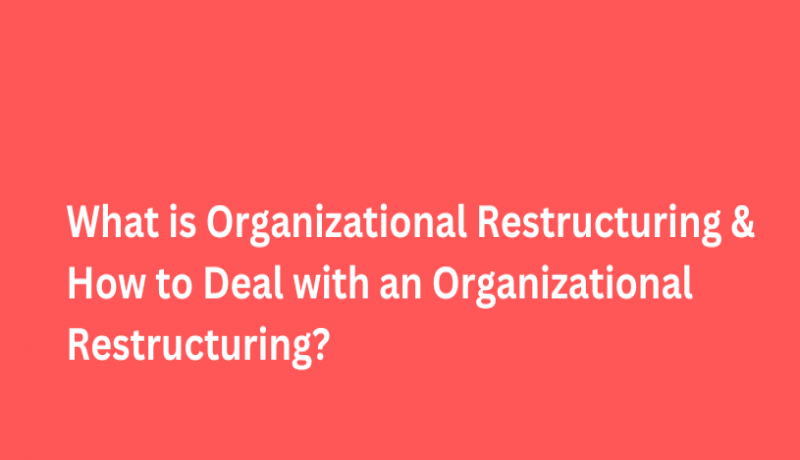What is Organizational Restructuring and How to Deal with an Organizational Restructuring?
Organizational restructuring refers to the process of making significant changes to the structure, roles, and processes within an organization.
This can be driven by various factors, such as changes in the business environment, shifts in strategic priorities, financial challenges, mergers and acquisitions, technological advancements, or the need to improve efficiency and effectiveness.
The primary goal of restructuring is typically to align the organization more closely with its goals and to enhance its overall performance.
Here are key aspects and common elements associated with organizational restructuring:
Reasons for Restructuring:
- Strategic Realignment: Adjusting the organization to better align with new business strategies and objectives.
- Cost Reduction: Streamlining operations to reduce expenses and improve financial performance.
- Mergers and Acquisitions: Integrating newly acquired companies or adapting to changes resulting from mergers.
- Market Changes: Responding to shifts in market conditions, customer preferences, or industry trends.
- Technological Advancements: Adapting to new technologies and digital transformation.
- Improving Efficiency: Enhancing operational efficiency and optimizing workflows.
Common Restructuring Actions:
- Organizational Redesign: Changing reporting structures, hierarchies, and team compositions.
- Staff Reduction: Implementing layoffs, early retirements, or voluntary separation programs.
- Role and Responsibility Changes: Reallocating tasks and responsibilities to enhance efficiency.
- Process Reengineering: Reviewing and redesigning core business processes to improve effectiveness.
- Outsourcing and Insourcing: Deciding whether to outsource certain functions or bring them in-house.
- Technology Integration: Adopting new technologies and systems to improve productivity.
Communication:
- Transparency: Open and honest communication about the reasons for restructuring and the expected impact on employees.
- Employee Engagement: Engaging with employees throughout the process, addressing concerns, and providing support.
- Leadership Communication: Clear communication from leadership about the vision, goals, and expected outcomes of the restructuring.
Employee Support:
- Training and Development: Providing training programs to help employees acquire new skills required in the restructured organization.
- Career Counseling: Assisting employees in navigating career changes and identifying new opportunities within the organization.
- Well-being Programs: Offering support services to help employees manage stress and cope with changes.
Legal and Ethical Considerations:
- Compliance: Ensuring that the restructuring process complies with relevant labor laws and regulations.
- Fairness: Treating employees fairly and avoiding discrimination during the restructuring process.
Measuring Success:
- Key Performance Indicators (KPIs): Establishing and monitoring KPIs to assess the success of the restructuring efforts.
- Feedback Mechanisms: Soliciting feedback from employees to identify areas for improvement and address concerns.
Organizational restructuring is a complex process that requires careful planning, effective communication, and a focus on both short-term and long-term goals.
It often involves challenges, but when executed thoughtfully, it can lead to a more agile, efficient, and competitive organization.
How to Successfully Navigate an Organizational Restructuring?
Navigating an organizational restructuring can be challenging, but with careful planning and a proactive mindset, you can successfully manage the changes. Here are some steps to help you navigate an organizational restructuring:
1. Understand the Changes
Obtain clear information about the restructuring, including the reasons behind it, the expected outcomes, and the new organizational structure.
Know how the changes will impact your role and responsibilities.
2. Stay Informed
Keep yourself updated on communication from the leadership team regarding the restructuring.
Attend town hall meetings, read internal communications, and seek clarification on any uncertainties.
3. Build a Network
Connect with key stakeholders, both within and outside your immediate team. Building strong relationships can help you navigate changes more smoothly.
4. Adaptability
Be flexible and open to change. Recognize that the restructuring may require adjustments to your workflow, tasks, and even reporting relationships.
5. Seek Clarification
If you have questions or concerns, don't hesitate to seek clarification from your supervisor or HR. Understanding the changes can help alleviate anxiety and uncertainty.
6. Skill Development
Identify any new skills or competencies that may be required in the restructured organization. Take proactive steps to acquire these skills through training or self-directed learning.
7. Embrace a Positive Attitude
Maintain a positive attitude and approach the restructuring as an opportunity for growth and development, both personally and professionally.
8. Communication
Communicate openly and honestly with your team and colleagues. Share information that is appropriate and encourage a culture of open communication.
9. Support Your Team
If you are a leader, support your team members through the changes. Address their concerns, provide guidance, and ensure that they have the resources they need to succeed.
10. Manage Stress
Restructuring can be stressful. Take care of your physical and mental well-being. Consider seeking support from employee assistance programs or counseling services if needed.
11. Update Your Network Profile
If there are changes to your role or responsibilities, update your internal and external profiles (such as LinkedIn) to reflect these changes.
12. Evaluate and Adjust Goals
Review your goals and objectives in light of the restructuring. Make necessary adjustments to align them with the new organizational priorities.
13. Monitor Progress
Keep track of how the restructuring is progressing. Be aware of any adjustments that may be required and stay engaged in the process.
Remember that organizational restructuring can be an ongoing process, and staying adaptable and proactive will serve you well as you navigate through these changes.








